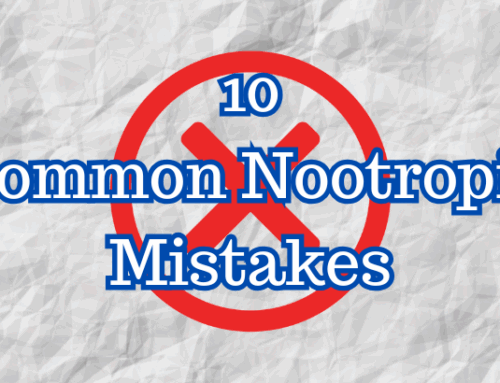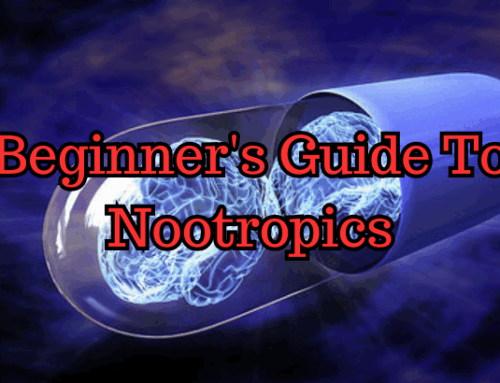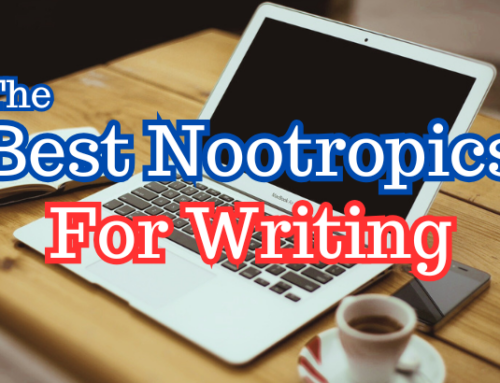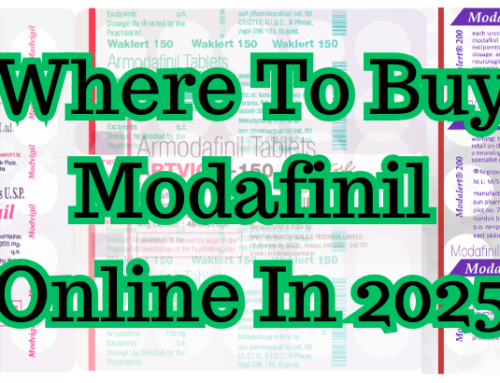One of the most common questions I get asked is: What is the strongest nootropic?
While this is a pretty straightforward question, unfortunately there is no straightforward answer. There are just too many different factors that need to be taken into consideration.
In this post, we're gonna look at some of those different factors. Then we'll explore some different nootropics to see what the strongest nootropic might be.
What Makes A Nootropic Strong?
The first thing we have to do is define the word strong. Actually, that's the second thing we have to do. First, we need to define the word nootropic.
A nootropic can broadly be defined as any substance that boosts cognitive performance. However, more specific definitions – including the original definition of the word – omit certain substances for one reason or another. To learn about these reasons, the origins of the word nootropic, who created it and a lot more, read this: What Is The Exact Definition of Nootropic?
Some definitions of the word nootropic include drugs like Adderall (amphetamine) and Ritalin (methylphenidate) because they can have a positive effect on cognitive performance. But other definitions exclude them because of their potential for abuse, addiction, and withdrawal.
This is an obvious problem. If we include a substance like Adderall, for example, it would surely be high up on the list of the strongest nootropics. But by many definitions, Adderall is not a true nootropic because tolerance develops quickly, there is a high potential for abuse, and it often comes with a laundry list of side effects.

It's impossible to say what the strongest nootropic is.
And what makes a nootropic strong? How it makes you feel? How long the effects last? How quickly it kicks in? How small a dosage you can use and get results? How much it increases your productivity?
See the problem here? There are a number of different ways we can define the word strong in this situation. Each definition might give us a different answer. Because of this, it makes it difficult – impossible, really – to label any single nootropic as the strongest nootropic.
Another problem we run into is the fact that nootropics affect people differently. Everyone's brain chemistry is unique. There is so much variation from person to person that it's impossible to make broad generalizations about strength. What you might consider to be the strongest nootropic may be a very weak one to someone else.
For these reasons, there's really no single correct answer to the question, what is the strongest nootropic? However, while we might not be able to pinpoint what the strongest nootropic is, we can certainly talk about what some strong nootropics are. Let's look at some strong nootropics, and what it is about them that makes them so powerful.
What Is The Strongest Nootropic?
As stated above, it's impossible to say what the strongest nootropic is since there's so much variation from one person to the next. But for most people, odds are it's something on this list. Here are some of the strongest nootropics that are being used around the world today.
Phenylpiracetam

By just about any definition, this is a strong nootropic. Phenylpiracetam a member of the racetam family, a group of chemically similar substances, many of which are nootropics. This powerful substance has been extensively studied in both humans and animals and has an excellent safety profile. It has been reported to increase focus, motivation, and memory.1 Phenylpiracetam can also improving mood and physical performance.2
Many people find phenylpiracetam to be mildly stimulating. Originally developed in Russia in the early 1980s, it's classified as a psychostimulant there. The Russians first developed phenylpiracetam for cosmonauts (astronauts) to reduce stress and increase performance in space.3
While it is available over-the-counter (OTC) in the United States and many other countries, phenylpiracetam is only available with a prescription in certain parts of the world. In Russia, for example, until recently it was sold as a prescription drug under the brand name Phenotropil. However, in April of 2017, Valenta Pharm – the company that manufactured Phenotropil in Russia – announced that it stopped production of phenylpiracetam for copyright/patent reasons.4

People who've used phenylpiracetam have reported a variety of nootropic benefits. Some even claim that it's as powerful as the prescription drug Adderall (though most people who've tried both – myself included – find it to be much milder). Here are some of phenylpiracetam's most commonly reported benefits:
- Increased focus
- Improved mood
- Improved memory
- Increased alertness
- Increased motivation
- Increased ability to learn
- Improved physical performance
- Reduced sensitivity to extreme temperatures
![]() How to take: Phenylpiracetam is usually taken in dosages of 100-300 milligrams, one to three times a day (for a total of 200-600 mg/day).6 For maximum absorption, take it on an empty stomach. If nausea or upset stomach occurs, taking phenylpiracetam with a snack or small meal should help. Lastly, some people find that taking a choline source like alpha-GPC with phenylpiracetam increases its effectiveness.
How to take: Phenylpiracetam is usually taken in dosages of 100-300 milligrams, one to three times a day (for a total of 200-600 mg/day).6 For maximum absorption, take it on an empty stomach. If nausea or upset stomach occurs, taking phenylpiracetam with a snack or small meal should help. Lastly, some people find that taking a choline source like alpha-GPC with phenylpiracetam increases its effectiveness.
Side-effects: Phenylpiracetam is generally very well-tolerated. Multiple studies have shown it to be safe, even in high doses taken daily for long periods of time. Side-effects are rare but may include headache, nausea, upset stomach, insomnia, agitation, and nervousness. Taking a choline source with phenylpiracetam may reduce or eliminate some of the side-effects (especially headaches).7
To learn more about this nootropic, check out this article: Phenylpiracetam – The Best Adderall Alternative?
Modafinil
 This is another nootropic that many users consider to be strong. Modafinil is one of the most popular nootropics being used around the world today. It's been extensively researched and shown to be both safe and effective.
This is another nootropic that many users consider to be strong. Modafinil is one of the most popular nootropics being used around the world today. It's been extensively researched and shown to be both safe and effective.
Modafinil is classified as a eugeroic.8 That's the medical term for a wakefulness-promoting agent. And for most people it definitely has a eugeroic effect. Modafinil users often report feeling more awake, alert, and focused. Personally, I experience all these effects from this popular nootropic.
First developed in France in the 1970s, modafinil didn't start to see widespread use until the 1990s. It became a prescription drug in France in 1994 (under the brand name Modiodal) and in the United States in 1998 (under the name Provigil). In both countries, modafinil is still sold as a prescription drug for the treatment of narcolepsy, shift work sleep disorder, obstructive sleep apnea, and other disorders.9
Modafinil users often report a number of potent nootropic benefits. Here are some of modafinil's potential nootropic benefits:
- Increased focus
- Increased wakefulness/alertness
- Reduced reaction time
- Increased motivation
- Reduced fatigue
- Improved overall cognitive performance
Not only have thousands of users reported these effects, there's plenty of science to support many of modafinil's nootropic benefits. One scientific review also noted that modafinil does not have a preponderance for side effects.10 It's generally considered to be safe and effective for most people.
Like phenylpiracetam, modafinil is also on the World Anti-Doping Agency's Banned Substances List.5 They don't go around banning every substance – just the ones that have to potential to enhance performance. And for many people, modafinil is definitely a cognitive-performance enhancer.
![]() How to take: The standard modafinil dosage is reported to be between 1-200 milligrams, taken in one or two doses.11 Modafinil usually comes in 200 mg tablets, so ½ to 1 tabs. It generally should not be taken late in the day, as this may cause insomnia. For maximum absorption, take modafinil on an empty stomach. If nausea or upset stomach occurs, you should take adrafinil with food.
How to take: The standard modafinil dosage is reported to be between 1-200 milligrams, taken in one or two doses.11 Modafinil usually comes in 200 mg tablets, so ½ to 1 tabs. It generally should not be taken late in the day, as this may cause insomnia. For maximum absorption, take modafinil on an empty stomach. If nausea or upset stomach occurs, you should take adrafinil with food.
Side-effects: Modafinil is well-tolerated by most people. Side effects are uncommon but may include headache, nausea, upset stomach, insomnia, dizziness, and anxiety.12 Taking modafinil with food may reduce or eliminate some gastrointestinal side effects.
If you would like to learn more about this potent nootropic, read this: Modafinil – A Powerful and Popular Nootropic.
Bromantane
This is probably the least commonly used substance on our list of the strongest nootropics. But that doesn't mean bromantane isn't powerful. In fact, it even made it onto our list of the 3 most underrated nootropics.

In Russia, bromantane is a prescription medication used to treat asthenic (weakness-related) and other disorders. In the United States and most other countries, it is sold as a dietary supplement. Controlled studies done in Russia have found bromantane to have cognition-enhancing (nootropic) properties and to be generally safe.15
And what do you know? Like the previous two substances, bromantane is on WADA's Banned Substances List.16 That means it must have some powerful performance-enhancing benefits. Here are some of the nootropic benefits that bromantane users often report:
- Improved mood
- Decreased anxiety
- Increased energy
- Improved physical performance
- Improved sense of well-being
![]() How to take: Typical bromantane dosages range from 50-100 mg/day, though some users take twice that. It is usually taken in a single dose early in the day but can be divided into two. Many bromantane users report that it takes several hours (up to 4) to kick in. Studies have shown that the effects come on gradually over the course of several hours and last for 8-12 hours.17 Taking bromantane on an empty stomach may increase its effectiveness.
How to take: Typical bromantane dosages range from 50-100 mg/day, though some users take twice that. It is usually taken in a single dose early in the day but can be divided into two. Many bromantane users report that it takes several hours (up to 4) to kick in. Studies have shown that the effects come on gradually over the course of several hours and last for 8-12 hours.17 Taking bromantane on an empty stomach may increase its effectiveness.
Side-effects: Studies have shown bromantane to have a very good safety profile. In fact, several human studies have look at bromantane's safety and found it to have few side effects, little or no potential for addiction, and to be safe to take long term.18
You can learn more about this nootropic here: The Nootropic Benefits of Bromantane.
Conclusion
As we have seen, there is no easy way to answer the question, what is the strongest nootropic? But now you know about at least three powerful nootropics that have lots of science and anecdotal reports to support their safety and effectiveness.
A different way of asking what the strongest nootropic is would be to ask what the best nootropic is to get a particular effect. For example, what is the best nootropic for focus? Check out our Best Nootropic For… series to find the best nootropics for focus, mood, creativity, learning, and more.
What do you think the strongest nootropic is? Have you found any of the substances mentioned in this post to be particularly potent? Please leave your answers in the comments section at the bottom.
To learn more about nootropics, sign up for the Nootropics Zone newsletter. You'll get the free gift, The Ultimate Nootropics Quick Reference Guide.
References
1Zvejniece, L., Svalbe, B., Veinberg, G., et al. (2011). Investigation into stereoselective pharmacological activity of phenotropil. Basic & Clinical Pharmacology & Toxicology, 109(5):407-12.
2Kim, S., Park, J., Myung, S., & Lho, D. (1999). Determination of carphedon in human urine by solid-phase microextraction using capillary gas chromatography with nitrogen-phosphorus detection. Analyst, 124(11):1559-62.
3Fedotova, O. (2004). Phenotropil: natural leadership. Remedium, 36.
4The production of a popular nootropic drug has been discontinued in Russia. (March 1, 2018). Best Medicine (вести медицина).
5The World Anti-Doping International Standard Prohibited List. (January 1, 2017). World Anti-Doping Agency.
6Phenylpiracetam. (October 2, 2018). Examine.
7Malykh, A., & Sadaie, M. (2010). Piracetam and piracetam-like drugs: from basic science to novel clinical applications to CNS disorders. Drugs, 70(3):287-312.
8Morgenthaler, T., Lee-Chiong, T., Alessi, C., et al. (2007). Practice parameters for the clinical evaluation and treatment of circadian rhythm sleep disorders – An American Academy of Sleep Medicine report. Sleep, 30(11):1445-59.
9Ballas, C., Kim, D., Baldassano, C., et al. (2002). Modafinil: past, present and future. Expert Review of Neurotherapeutics, 2(4):449-57.
10Battleday, R., & Brem, A-K. (2015). Modafinil for cognitive neuroenhancement in healthy non-sleep-deprived subjects: a systematic review. European Journal of Neuropsychopharmacology, 25(11):1865-81.
11Provigil prescribing information. (August 17, 2007). Retrieved September 24, 2021 from https://www.accessdata.fda.gov/drugsatfda_docs/label/2007/020717s020s013s018lbl.pdf
12Greenblatt, K., & Adams, N. (2021). Modafinil. In: StatPearls. Treasure Island: StatPearls Publishing.
13Mandell, L., Woodhead, M., Ewid, S., et al. (2006). Respiratory Infections. CRC Press: London.
14Iezhitsa, I., Spasov, A., & Bugaeva, L. (2001). Effects of bromantan on offspring maturation and development of reflexes. Neurotoxicology and Teratology, 23(2):213-22.
15Voznesenskaia, T., Fokina, N., & Iakhno, N. (2010). Treatment of asthenic disorders in patients with psychoautonomic syndrome: results of a multicenter study on the efficacy and safety of ladasten. Zhurnal Nevrologii Psikhiatrii Imeni S.S. Korsakova, 110(5 Pt 1):17-26.
16Burnat, P., Payen, A., Brumant-Payen, C., et al. (1997). Bromantan, a new doping agent. Lancet, 350(9082):963-4.
17Mikhaylova, M., Vakhitova, J., Yamidanov, R., et al. (2007). The effects of ladasten on dopaminergic neurotransmission and hippocampal synaptic plasticity in rats. Neuropharmacology, 53(5):601-8.
18Oliynyk, S., & Oh, S. (2012). The pharmacology of actoprotectors: practical application for improvement of mental and physical performance. Biomolecules & Therapeutics, 20(5):446-56.
[This article was originally published on March 4, 2016. Updated September 24, 2021.]







Leave a Reply